Technology Use in Mortgage Shopping: Practices and Opportunities
 This study was highlighted in a feature article by Steve Deggendorf in the March 2014 issue of the MBA's Mortgage Banking Magazine
This study was highlighted in a feature article by Steve Deggendorf in the March 2014 issue of the MBA's Mortgage Banking Magazine
Careful shopping could help mortgage borrowers obtain better outcomes, including lower costs, fewer surprises at the loan closing table, and higher long-term satisfaction with their choices. In the second quarter of 2013, we collected data through the Fannie Mae National Housing Survey (NHS) to take a deeper look at how borrowers shop for mortgages and use technology while doing so.
We found distinct differences in the shopping behaviors of higher and lower income mortgage borrowers similar to our 2012 shopping analysis results. Our 2013 findings also suggest opportunities for online tools to improve the ability of all borrowers to shop for a mortgage. We define lower income borrowers as those with family incomes of less than $50,000 and higher income borrowers as those with family incomes of more than $100,000.
In general, we found that higher income borrowers say they are more likely than lower income borrowers to rely on their own calculations while mortgage shopping (Table 1). Lower income borrowers say they are more likely than higher income borrowers to rely on real estate agents, mortgage lenders, family, and friends for advice and recommendations in the mortgage shopping process. In addition, we found that higher income mortgage borrowers more often say that improved ability to compare multiple loan offers would make the mortgage shopping process easier, while lower income consumers more often say they would like to have easier to understand loan terms and costs.
Table 1: Key Mortgage Shopping Differences Between Income Groups
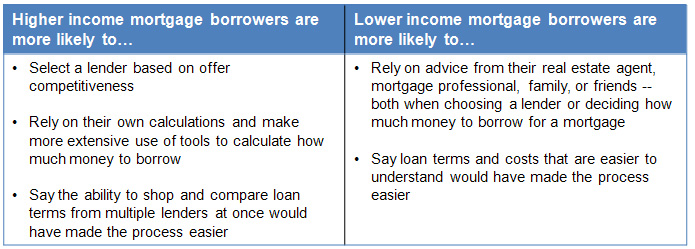
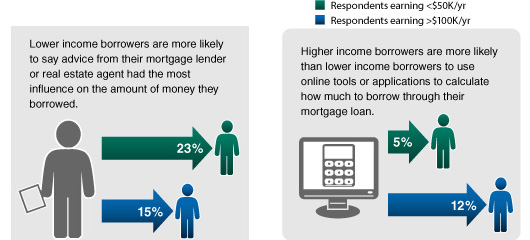
Higher income borrowers are using online shopping approaches about twice as frequently as lower income borrowers (Chart 1), which aligns with a stronger focus on doing their own calculations and using tools as noted above. However, all income groups aspire to use the Internet even more than they currently do indicating that online technology will likely play an increasingly larger role for all borrowers in the mortgage shopping process and presents opportunities for shopping enhancements.
Chart 1: Past and Aspirational Technology Use in Mortgage Shopping by Income Group
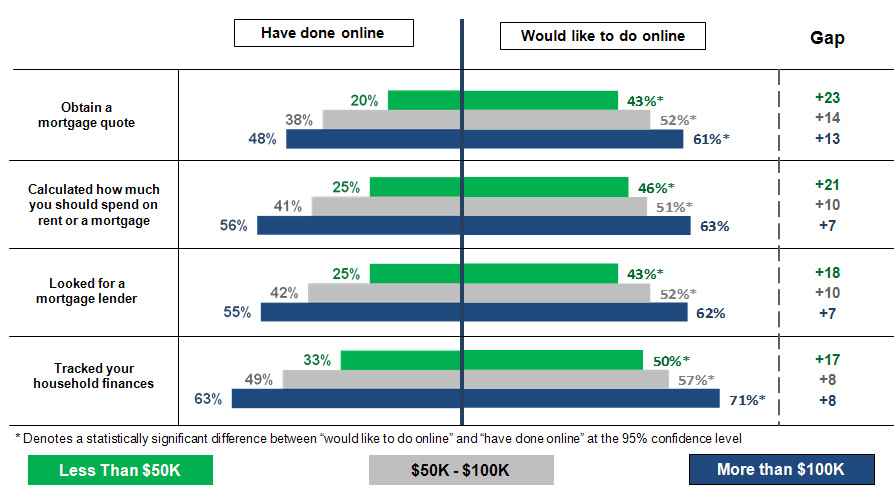
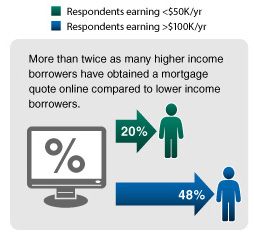
Consumers say they use traditional personal computer technology to do their mortgage shopping much more so than mobile technologies such as smart phones or tablets. The use of technology is more pronounced among more recent mortgage borrowers – those who have gotten their mortgage in the last three years (Chart 2). This may partially be explained by the borrower having recently shopped for a mortgage and the general growing use of online tools, as well as having higher incomes and education levels than prior mortgage borrowers.
Chart 2: Technology Type Use by Recent and Prior Borrowers
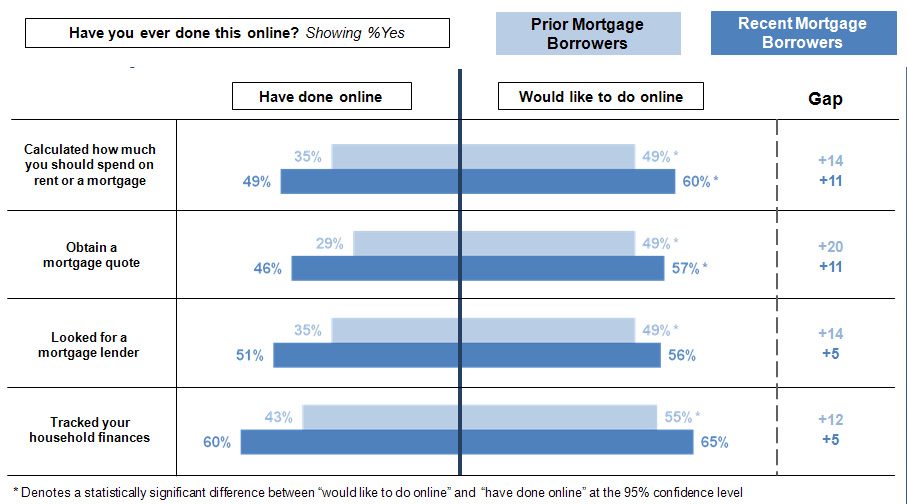
Possibly contrary to the sharp growth in the general use of mobile technology, borrowers also told us they will use personal computer technology significantly more so in the future than mobile technology to shop for their mortgage and manage their personal finances. In addition, consumers say that social media plays a small role in mortgage shopping now and is likely to play a small role in the future.
Many researchers such as the Pew Internet & American Life Project have observed that consumers are using online research and mobile tools to enhance their shopping experience by helping them obtain product reviews and price comparisons while at home and in-store1. We will see in the coming years what inroads enhanced technology tools make into improving outcomes in more complex activities like mortgage shopping. For instance, mobile tools hold the promise of offering real time information and education where and when it is needed, for example, when visiting homes for sale or shopping for a mortgage in a face-to-face setting. Enhanced online tools, especially given the aspiration to use them much more often in the future, could help consumers of all incomes to become better mortgage shoppers and achieve better outcomes by addressing the issues they think will make the process easier, such as enhancing their understanding of mortgage terms and costs and their ability to make simultaneous comparisons of loan terms from multiple lenders.
To learn more about our 2013 analysis of technology use in mortgage shopping, read our Fannie Mae National Housing Survey Topic Analysis.
Steve Deggendorf
Director, Business Strategy
Economic & Strategic Research
January 2, 2014
Opinions, analyses, estimates, forecasts and other views of Fannie Mae's Economic & Strategic Research (ESR) group included in this commentary and related Housing Insights should not be construed as indicating Fannie Mae's business prospects or expected results, are based on a number of assumptions, and are subject to change without notice. How this information affects Fannie Mae will depend on many factors. Although the ESR group bases its opinions, analyses, estimates, forecasts and other views on information it considers reliable, it does not guarantee that the information provided in these materials is accurate, current or suitable for any particular purpose. Changes in the assumptions or the information underlying these views could produce materially different results. The analyses, opinions, estimates, forecasts and other views published by the ESR group represent the views of that group as of the date indicated and do not necessarily represent the views of Fannie Mae or its management.
The views expressed in these articles reflect the personal views of the authors, and do not necessarily reflect the views or policies of any other person, including Fannie Mae or its Conservator. Any figures or estimates included in an article are solely the responsibility of the author.
1. Pew Internet and American Life Project www.pewinternet.org
